I have wanted to do this forever. Anyone that has thrown a cup or bowl off the hump, on a potter’s wheel knows the lovely mark of a piece of twisted thread that appears on the bottom of the piece as you cut it off.…it is process and beauty all at once. I tried to get this “mark” on the top of dinner wares, but for any number of reasons it just never worked. One of the big reasons was unity. I could not figure out how to make marks on both sides of the plates that have equal importance and energy. The idea just went into compost. Until now.
I take my lessons from some early Chinese and Japanese platters that I saw many years ago. They had some of the most lyrical and joyful brushwork on the back of the plates I had ever seen. The service side of the platters were handled with exquisite care, and were beautifully done. Whoever trimmed the feet on the platters did a good job too. At the last minute it was handed it off to someone for glazing, but not before someone added a little touch of joy with a brush loaded with cobalt…loose, and happy and forever. I found that joy lacking on the service side…good work, but tight, controlled and …well, worked. No unity. At least I was paying attention!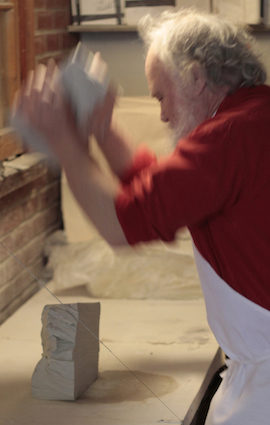 The beginning point for these dishes is the way that I wedge clay. Many years ago, I found that the cut and slam method of mixing clays of different specific gravity i.e. Hardness or softness, was also a good way to wedge. I like my porcelain just a bit dryer than some potters, so the Asian way of spiral wedging does not work very well. As it turns out, my way is also the way the Renaissance German potters wedged their clay when making salt glazed wares, so tradition lives on. My peasant lineage has German in it, so I like this little bit of linkage.
The beginning point for these dishes is the way that I wedge clay. Many years ago, I found that the cut and slam method of mixing clays of different specific gravity i.e. Hardness or softness, was also a good way to wedge. I like my porcelain just a bit dryer than some potters, so the Asian way of spiral wedging does not work very well. As it turns out, my way is also the way the Renaissance German potters wedged their clay when making salt glazed wares, so tradition lives on. My peasant lineage has German in it, so I like this little bit of linkage.
Once the lump of clay is wedged, I slam it down into the diameter that I want for the hump mold. The slab is cut with a unique tool (based on a saw design), and carried to the mold. Feet are added, and a plate is made. There is a lot of baby-sitting. The drying room is critical for this type of work. It must have a relative humidity of about 80 to 90%, and the temperature should be warm…25 deg. C. or about 75 deg. F. most of the time. In those conditions, the porcelain dries from the inside out at the same time…cutting down dramatically on cracking. The first day or two of drying takes place on the hump mold. When the initial slab is leather hard, it can be flipped to service side up on a dry wall slab. Drying time in those conditions should take about 10 days minimum.
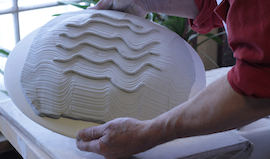 Once dry, the sharp edges need to be carefully sponged to slightly round edges so they don’t cut or chip easily…these are after all functional dinner plates. I don’t want to spoil the cutting lines by over-sponging, but the edges do get a lot of attention, without spoiling the natural forms given to it by the shape of the wedged clay.
Once dry, the sharp edges need to be carefully sponged to slightly round edges so they don’t cut or chip easily…these are after all functional dinner plates. I don’t want to spoil the cutting lines by over-sponging, but the edges do get a lot of attention, without spoiling the natural forms given to it by the shape of the wedged clay.
Once dry, and in the bisque kiln, they are very slowly warmed…one full day to 100 deg. C. or 212 deg. F and then the usual bisque. The glaze technique is normal for me. The application of my celadon is a bit thicker than normal as I want an unctuous, fatty feeling on both sides.
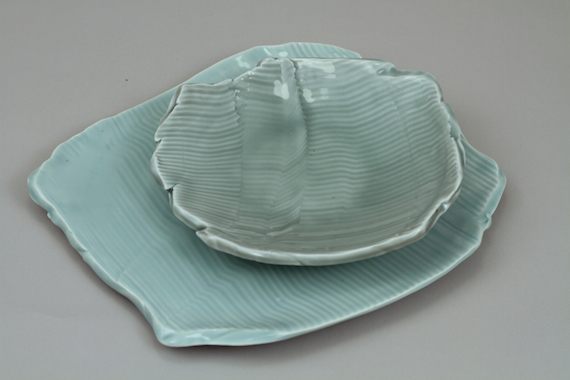 In the end, I have a dinner service that looks like someone cared about each and every surface. The dinner ware is heavy and durable, and each piece is absolutely unique but not so much as to destroy the idea of a “set”. I want my dinner guests to be honored as individuals by having individual platters and bowls. I also want the person who washes the dishes to like the underside as much as the service side, and I want them to handle the ware with confidence and joy. Eating and cooking together is basic human activity, and all aspects of it should be enjoyed.
In the end, I have a dinner service that looks like someone cared about each and every surface. The dinner ware is heavy and durable, and each piece is absolutely unique but not so much as to destroy the idea of a “set”. I want my dinner guests to be honored as individuals by having individual platters and bowls. I also want the person who washes the dishes to like the underside as much as the service side, and I want them to handle the ware with confidence and joy. Eating and cooking together is basic human activity, and all aspects of it should be enjoyed.
Visit Harlan’s Facebook page.


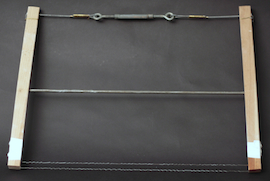
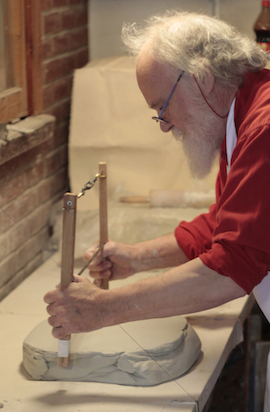


Comments 7
Harlan, you are forever making beautiful work. Your an inspiration to so many of us. Keep up the great work. All good things for you.
Donn
BEAUTIFUL dinner ware!
Many thanks for sharing the process in words and animation …. excellent images. A problem for me would be choosing which side to eat from, drying dishes would be a treat only after licking the platter clean.
Kudos to Abe for creating such a wonderful site.
Jack
Love your slumped dinnerware. I also slam wedge, then do a bit of spiral wedge to get into a throwing shape, roundish. I love the idea of using as is and taking advantage of the texture. Thank you.
Also in your post on your celadon thanks for the suggestions to mix by adding the iron oxide first and then blunge. Another use of that word, what is blunging? Heard it first in relation to attaching then pulling handles.
What kind of wiggle wire did you find to be strong enough to pull through? I LOVE this and have tried to make the plates unsuccessfully. The wire breaks. Thank you in advance for your time and great ideas.
Author
Hi Judy,
The wire used is called piano wire, and it comes from the far right hand side of the piano, so it is fine but still very strong. I use a set of needle nose pliers to bend the notch pattern. You can control the size of the notch, and the frequency so in the end you can control the composition of the slabs. I used the “stacking boards” technique and one wire for a starting point, but find the bow saw tool much better. It makes more parallel slabs, making the drying better. You might consider using softer clay too. Because this technique calls for plaster drape molds, soft clay can be placed on them, and the drying is helped by the plaster. I leave the slabs on the plaster at least one day, and sometimes two depending on the RH of the drying room. Ideal drying is about 80% RH at above room temperatures…slow but sure. Good luck with this.
Kind thoughts,
Harlan
Thank you so much! I will try the piano wire. Thank you for writing back to me with such great detail. I really appreciate it!!!!!!!
Okay, I have been researching piano wires. But, are you using the copper winding around a replacement for the wire? When you say the far right side of the piano, how thick is it? I really appreciate your help. I am determined to make this!!!!
Many thanks.
Judy